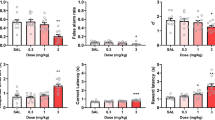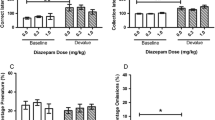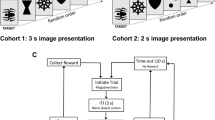Abstract
The effects of benzodiazepine receptor (BZR) full agonists chlordiazepoxide and midazolam, and the partial agonistβ-carboline ZK 91 296 on the rat's performance in a simple reaction time paradigm were examined. This task required the animals to respond to a rarely and unpredictably occurring brief (50 ms) visual stimulus. Non-parametric measures of signal sensitivity and response bias derived from signal-detection theory were used as a basis for the dissociation between the effects of these drugs on attentional abilities and general responsivity. The dose-dependent effects of midazolam (0.1–3.13 mg/kg) on signal sensitivity and general responsivity occurred in parallel. In contrast, the effects of chlordiazepoxide (1.56–12.5 mg/kg) on signal sensitivity were largely independent from effects on response bias. The partial agonist ZK 91 296 (0.39–25 mg/kg) in general had little effect on performance. The effects of the highest doses of chlordiazepoxide and midazolam were reversed by the co-administration of the BZR antagonist Ro15-1788 (15 mg/kg). Additionally, extension of the stimulus presentation time to 500 ms decreased the magnitude of the effect of chlordiazepoxide on signal sensitivity. These results support the hypothesis that BZR agonist-induced disruption of attentional abilities is not necessarily confounded by effects on general responsivity or sedation, and thus may represent a discrete pharmacological property of BZR-agonists.
Similar content being viewed by others
References
Baddeley AD (1986) Working memory. Clarendon Press, Oxford
Barrett JE, Brady LS, Witkin JM (1985) Behavioral studies with anxiolytic drugs. I. Interactions of the benzodiazepine antagonist Ro15-1788 with chlordiazepoxide, pentobarbital and ethanol. J Pharmacol Exp Ther 233:554–559
Bruno JP, Moore H, Duchenko P, Sarter M (1992) Modulation of frontal cortical acetylcholine release by benzodiazepine receptor ligands: age-dependent effects and behavioral correlates. In: Meyer EM, Crews FT, Simpkins JW (eds) The treatment of dementias: a new generation of progress. Plenum Press, New York (in press)
Cole SE (1986) Effects of benzodiazepines on acquisition and performance: a critical assessment. Neurosci Biobehav Rev 10:265–272
Cole SE (1988) Dose-dependent reversal of chlordiazepoxide-induced discrimination impairment by Ro 15-1788. Psychopharmacology 96:458–461
Craik FIM, Byrd M (1982) Aging and cognitive deficits. The role of attentional resources. In: Craik FIM, Trehub S (eds) Aging and cognitive processes. Plenum Press, New York, pp 191–211
Curran HV (1991) Benzodiazepines, memory and mood: a review. Psychopharmacology 105:1–8
Curran HV, Birch B (1991) Differentiating the sedative, psychomotor and amnesic effects of benzodiazepines: a study with midazolam and the benzodiazepine antagonist, flumazenil. Psychopharmacology 103:519–523
Falk JL, Lau CE (1991) Synergism by caffeine and by cocaine of the motor control deficit produced by midazolam. Pharmacol Biochem Behav 39:525–529
Francis RL, Cooper SJ (1979) Chlordiazepoxide-induced disruption of discrimination behavior: a signal detection analysis. Psychopharmacology 63:307–310
Frey PW, Colliver JA (1973) Sensitivity and responsivity measures for discrimination learning. Learn Motiv 4:327–342
Ghonheim MM, Mewaldt SP, Berie JL, Hinrichs JV (1981) Memory and performance effects of single and 3 week administration of diazepam. Psychopharmacology 73:147–151
Hennessy MJ, Kirkby KC, Montgomery IM (1991) Comparison of the amnesic effects of midazolam and diazepam. Psychopharmacology 103:545–550
Hodges HH, Green S (1986) Effects of chlordiazepoxide on cued radial maze performance in rats. Psychopharmacology 88:460–466
Jackson HC, Nutt DJ (1990) Body temperature discriminates between full and partial benzodiazepine receptor agonists. Eur J Pharmacol 185:243–426
Koelega HS (1989) Benzodiazepines and vigilance performance: a review. Psychopharmacology 98:145–156
Ksir C, Slifer B (1982) Drug effects on discrimination performance at two levels of stimulus control. Psychopharmacology 76:286–290
Lau CE, Falk JL, Tang M (1990) Motor performance decrement by midazolam: antagonism by Ro 15-1788 and CGS 8216. Pharmacol Biochem Behav 36:139–143
Lister RG (1985) The amnesic action of benzodiazepines in man. Neurosci Biobehav Rev 9:87–94
Lucki I, Rickels K, Geller AM (1986) Chronic use of benzodiazepines and psychomotor and cognitive test performance. Psychopharmacology 88:426–433
Mackworth NH (1957) Some factors affecting vigilance. Adv Sci 53:389–393
Margules DL, Stein L (1967) Neuroleptics versus tranquilizers: Evidence from animal studies of mode and site of action. In: Brill H, Cole JO, Deniker P, Hippius H, Bradley PB (eds) Neuropsychopharmacology. Amsterdam, Exerpta Medica, pp 108–120
Nissen MJ, Bullemer P (1987) Attentional requirements of learning: evidence from performance measures. Cog Psychol 19:1–32
Parasuraman R (1984) Sustained attention in detection and discrimination. In: Parasuraman P, Davis DR (eds) Varieties of attention. Academic Press, New York, pp 243–271
Patat A, Klein MJ, Surjus A, Hucher M, Granier J (1991) Study of potential reversal of triazolam memory and cognitive deficits by RU 41 656 in healthy subjects. Psychopharmacology 104:75–80
Sahgal A (1987) Some limitation of indices derived from signal detection theory: evaluation of an alternative index for measuring bias in memory tasks. Psychopharmacology 91:517–520
Sahgal A (1988) Vasopressin and amphetamine, but not desglycinamide vasopressin, impair positively reinforced visual attention performance in rats. Behav Brain Res 29:35–42
Saghal A, Iversen SD (1978) The effects of chlordiazepoxide on a delayed pair comparison task in pigeons. Psychopharmacology 59:57–64
Sanger DJ, Zikovic B (1987) Discrimination stimulus properties of chlordiazepoxide and zolpidem. Agonist and antagonist effects of CGS 9896 and ZK 91296. Neuropharmacology 26:499–505
Sarter M (1990) Retrieval of well-learned propositional rules: insensitive to changes in activity of individual neurotransmitter systems? Psychobiology 18:451–459
Spencer DG Jr, Emmett-Oglesby MW (1985) Parallel processing strategies in the application of microcomputers to the behavioral laboratory. Behav Res Meth Instrument 17:294–300
Stephens DN, Sarter M (1988) Bidirectional nature of benzodiazepine receptor ligands extends to effects on vigilance. In: Hindmarch I, Ott H (eds) Benzodiazepine receptor ligands, memory and information processing. Springer, Berlin Heidelberg New York, pp 205–217
Stephens DN, Duka T, Andrews JS (1991) Benzodiazepines, betacarbolines and memory. In: Weinman J, Hunter J (eds) Memory: neurochemical and abnormal perspectives. Harwood Academic Publishers, Chur, pp 11–41
Stolerman LP, Gurcha HS, Rose IC (1986) Midazolam cue in rats: effects of Ro 15-1788 and picrotoxin. Psychopharmacology 89:183–188
Turski L, Niemann W, Stephens DN (1990) Differential effects of antiepileptic drugs andβ-carbolines on seizures induced by excitatory amino acids. Neuroscience 39:799–807
Woudenberg F, Slangen JL (1989) Discriminative stimulus properties of midazolam: comparison with other benzodiazepines. Psychopharmacology 97:466–470
Zikovic B, Perrault G, Morel E, Sanger DJ (1988) Comparative pharmacology of zolpidem and other hypnotics and sleep inducers. In: Sauvanet JP, Langer SZ, Morselli PL (eds) Imidazopyridines in sleep disorders. Raven Press, New York, pp 111–121
Author information
Authors and Affiliations
Rights and permissions
About this article
Cite this article
Dudchenko, P., Paul, B. & Sarter, M. Dissociation between the effects of benzodiazepine receptor agonists on behavioral vigilance and responsivity. Psychopharmacology 109, 203–211 (1992). https://doi.org/10.1007/BF02245501
Received:
Revised:
Issue Date:
DOI: https://doi.org/10.1007/BF02245501




